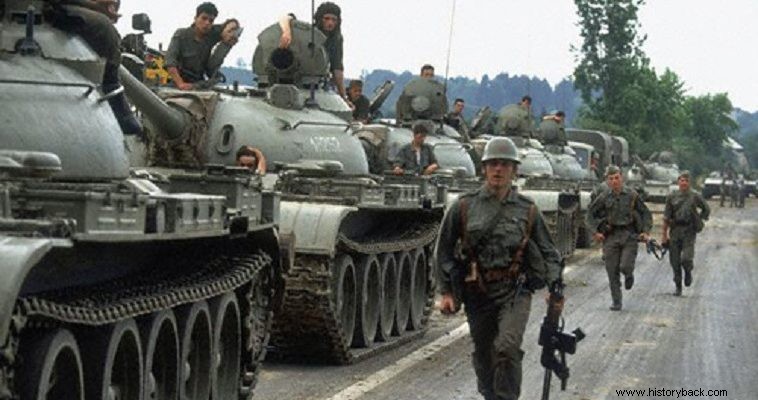
After the death of Tito the mortal formation called Yugoslavia began to creak dangerously. As in the period 1918-41, so now the peoples who had not so voluntarily joined the Yugoslav state, and with foreign encouragement, began to claim their independence.
Yugoslavia was a creation of the Treaty of Versailles. In its territory lived Serbs, Croats, Bosnian Muslims, Slovenes, Montenegrins and, by Tito's choice, "Macedonians". In 1989, Slobodan Milosevic assumed the leadership of the state.
In 1990 Slovenia, supported by Germany and the Vatican, held a referendum in which 94.8% of voters favored independence from the Yugoslavian federation a. Belgrade was not pleased to see this development and prepared to take military measures. The Slovenians mobilized and knowing that they could not oppose the Yugoslav army adopted asymmetric tactics. On June 25, 1991, Slovenia declared its independence.
The war begins
The following day the 13th Army Corps (SS) of the Yugoslav Army moved towards the Slovenian border. Slovenians reacted with roadblocks and demonstrations. The Slovenians did not open fire. It was a Yugoslav officer who did it on June 27, 1991, at 2:30 p.m., starting a devastating war which, for reasons unknown in Greece, some insist on characterizing as a "civil war".
On June 27, Yugoslav forces crossed the border and entered Slovenian territory, spearheaded by the 1st Armored Brigade (TTH/TX) and the 306th Anti-Aircraft Artillery Regiment (SAP). Yugoslav forces easily captured Brnik airfield. At the same time, Yugoslav aircraft were dropping announcements.
Yugoslavs did not expect armed resistance. So they were completely surprised when two helicopters were shot down by the Slovenians with SA-7 portable anti-aircraft launchers. At the same time, Slovenian forces counterattacked at Brnik airport and after a battle captured most of the Yugoslav soldiers there.
At the same time the tanks of the Yugoslav 32nd Infantry Division were stopped in Ormoj. The Yugoslavs, however, managed to cut off Slovenia from Italy and Austria, occupying almost all the border crossings.
General attack
However, the next day, June 28, the Slovenes launched a general counter-attack. In many cases Yugoslav forces were surrounded. An armored Yugoslav phalanx was also immobilized. The Yugoslav Air Force carried out raids. However, the Slovenians destroyed two Yugoslav T-55 tanks and captured three others. The Yugoslavs had three dead, 16 wounded and 98 prisoners.
At the border crossing of Holmets, the Slovenes, with two casualties, killed three and captured 91 Yugoslavs. In the meantime, the Yugoslav air force launched new raids. By the end of the day the Yugoslavs were under severe pressure as the Slovenes in their ranks deserted. The next day the Yugoslav forces at the Ljubljana airport surrendered as they had been surrounded at night by the Slovenes. Also the Slovenes captured several more Yugoslav tanks.
At the same time, however, the diplomatic struggle also began with European intervention. Slovenians and Yugoslavs agreed to a cease-fire. However, the agreement was not implemented. On June 30, the Yugoslav garrisons in Dravograd, Tolmin and Bovec to surrender.
To cease fire
On July 1st the 306th SAP trying to retreat was surrounded. The next day the Yugoslavs suffered significant losses in the Kraków Forest, while their 4th Infantry Division failed to break through the Slovenian defenses at Bregana. The Slovenians also recaptured four border crossings.
That same night the Slovenians proposed a ceasefire but the Yugoslavs did not accept the proposal. On July 3 a powerful motorized phalanx left Belgrade for Slovenia but never arrived due to mechanical breakdowns, according to the official version.
In the following days the ceasefire agreement finally came into effect and the Slovenians allowed the Yugoslav forces to withdraw. The withdrawal was completed on October 26, 1991. In the fighting, the Yugoslavs had 44 dead, 146 wounded and nearly 5,000 prisoners. The Slovenians lost 18 dead and had 182 wounded.
12 foreigners were also killed, mainly journalists. In terms of material the Yugoslavs lost 31 tanks, 22 armored vehicles, six helicopters, 87 guns and many anti-aircraft guns and launchers. A dark spot in the conflict is the so-called Holmetz massacre where armed Slovenes apparently killed Yugoslav soldiers who were trying to surrender. In the conflict, the Yugoslav army lost 22,300 men against approximately 45,000 Slovenians.
